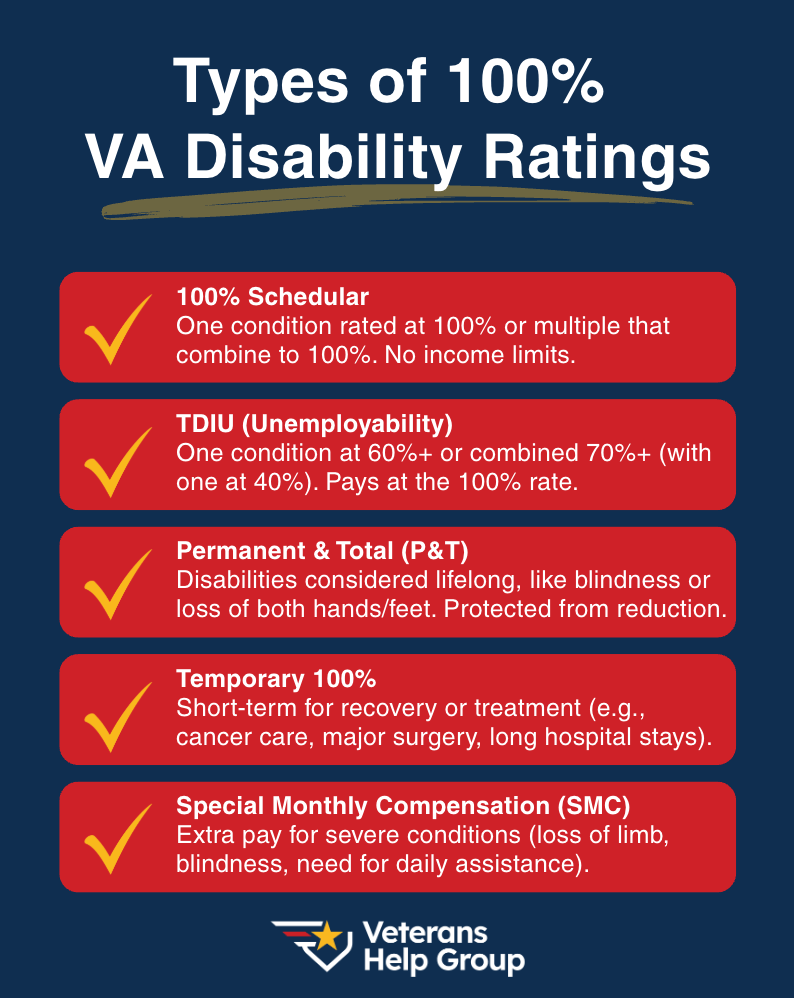
Table Of Contents
Different Types of 100% VA Disability Ratings (Updated September 2025)
If you’re applying for or already receiving veterans disability benefits, you likely know that a 100% disability rating offers the most comprehensive benefits.
A veteran with a 100% disability rating receives full monthly disability pay ($3,831.30/month in 2025 for the veteran alone, up from $3,621.95 in 2023). This rate increases with qualifying dependents. Looking ahead, 2026 rates are projected to rise by about 2.7%, bringing monthly pay close to $3,934.74.
But here’s what many veterans don’t realize: there are several different ways to qualify for 100% VA disability benefits including some options available even if your rating isn’t technically at 100%.
How to Qualify for a 100% VA Disability Rating
The first and best-known way to receive full veterans disability benefits is to be rated 100% disabled. This may mean being assigned a 100% disability rating for a single service-connected disability or reaching 100% disability through a combination of two or more service-connected conditions. You may hear this described as a 100% schedular rating.
Unlike Social Security Disability and most other types of disability benefits, veterans disability benefits may be available even if you are working–no matter how much money you earn. That’s because the disability rating is based on your limitations, not specifically on your ability or inability to engage in substantial gainful activity.

TDIU Benefits – Another Route to Benefits at the 100% Level
If the VA finds that a veteran is unemployable due to service-connected disabilities, they may be deemed individually unemployable. In that case, the veteran may be entitled to VA disability benefits at the 100% level if either:
- They have a disability rating of at least 60% for a single condition, or
- They have a disability rating of at least 70% based on combined conditions, with at least one condition rated at 40% or higher
If the VA determines your service-connected conditions prevent you from maintaining gainful employment, you’ll be paid at the 100% rate through TDIU.
Permanent and Total Disability (P&T)
A P&T rating means your disability is considered both permanent and total. Once granted, the VA generally won’t re-examine your condition or reduce your rating.
Examples of conditions that may qualify:
- Total blindness in both eyes
- Loss of both hands or both feet
- Other severe, non-improving conditions
While P&T ratings are designed to be lifelong, the VA can still review them in very rare situations (fraud, clear error, or misrepresentation). For most veterans, P&T provides strong protection and peace of mind.
Temporary 100% Ratings
Not all 100% ratings are permanent. Veterans may qualify for a temporary 100% disability rating while undergoing treatment or recovery for a service-connected condition.
Common examples include:
- Cancer treatment (like for Agent Orange–related lymphoma)
- Hospitalization for more than 21 days
- Recovery from surgery for a service-connected condition
These ratings remain in place until the recovery period is over.
Special Monthly Compensation (SMC)
Some veterans rated at 100% may also qualify for Special Monthly Compensation (SMC), additional, tax-free benefits provided when disabilities are especially severe (such as loss of use of limbs, blindness, or the need for aid and attendance). Even smaller SMC levels like SMC-K add extra compensation each month.
This extra tax-free benefit applies in cases of:
- Loss of limbs
- Severe vision or hearing loss
- Needing “aid and attendance” for daily activities
Even at smaller levels, like SMC-K, which adds about $136/month, this can significantly increase your total benefits.
Talk to a VA Disability Benefits Advocate
The path to the maximum veterans disability benefits you deserve is complicated, and your success may depend on how clear and thorough your claim is. At Veterans Help Group, we’ve helped thousands of disabled veterans apply for benefits and/or appeal denials or disability ratings.
We know what type of evidence the VA is looking for to establish a claim, and we can help you submit the most effective claim or appeal possible. To learn more, call 855-855-8992 or click here to contact us for a free consultation.
Disabled Veteran Resources:

VA Dental Benefits and Disability Ratings For Teeth
VA Dental Benefits and Ratings for Teeth - MATT SAUERWALD, VICE-PRESIDENT, VETERANS HELP...

Veterans Help Group Sponsors the 34th Annual Legends Invitational at Pebble Beach
Veterans Help Group Sponsors the 34th Annual Legends Invitational at Pebble Beach Veterans Help...

Top Veteran Questions Answered: Reddit’s Most-Asked VA Disability Questions
Top Veteran Questions Answered: Reddit’s Most-Asked VA Disability Questions Look, we get it. The...





